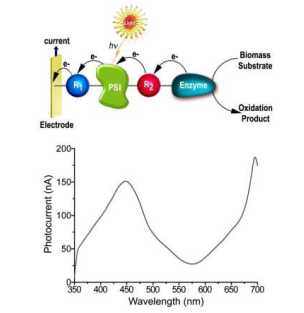Jan 20 2016
Researchers from The Hebrew University of Jerusalem, in Israel, and the University of Bochum, in Germany, have introduced a new method in the making of photo-bioelectrochemical cells. This discovery has been reported in Nature Energy.
 (Image courtesy Prof. Itamar Willner)
(Image courtesy Prof. Itamar Willner)
Photo-bioelectrochemical cells are based on native photosynthetic reaction, and this design is currently popular as it used for converting solar energy into electrical power.
Photosynthetic reaction, in the natural photosynthetic apparatus, is linked to biocatalytic transformations resulting in the fixation of CO2 and the evolution of O2.
The linking of photosystems to enzymes in order to develop photo-bioelectrocatalytic solar cells is still a challenging process, even though a significant growth has been demonstrated in the conjugation of native photosystems with electrodes to carry out the light-to-electrical energy conversion process.
Researchers have commented on the development of photo-bioelectrochemical cells, using the enzymes glucose dehydrogenase or glucose oxidase and the native photosynthetic reaction. The system is made up of integrated electrodes that are modified and comprise photosystem I, which is the natural photosynthetic reaction center. Chemical electron transfer mediators are used to electrically wire all the native proteins. Electric power is generated through the photoirradiation process of the electrodes when the glucose substrate is oxidized in place of a fuel.
Through this new system, the native photosynthetic apparatus can be used to convert solar light energy into electricity using biomass substrates. A number of bioelectrochemical systems have been using electricity to oxidize glucose. This new discovery highlights the utilization of native photosystems to obtain electrical power by using light as its source of energy. The photo-bioelectrochemical cells help in photonically driving biocatalytic fuel cells during the generation of electricity from solar energy.
The study results provide a general approach to assemble photo-bioelectrochemical solar cells with wide implications for solar energy conversion, bioelectrocatalysis and sensing.
Professor Itamar Willner, Hebrew University’s Institute of Chemistry
The research was headed at the Hebrew University by Prof. Itamar Willner, Institute of Chemistry and Minerva Center for Biohybrid Complex Systems, in collaboration with Prof. Rachel Nechushtai, Alexander Silberman Institute of Life Sciences and Minerva Center for Biohybrid Complex Systems; and at Ruhr-Universität Bochum, byProf. Wolfgang Schuhmann, Analytical Chemistry, Center for Electrochemical Sciences (CES).